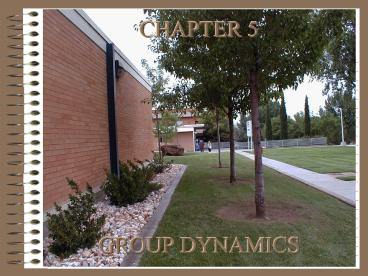CHAPTER 5 GROUP DYNAMICS PowerPoint PPT Presentation
Title: CHAPTER 5 GROUP DYNAMICS
1
CHAPTER 5GROUP DYNAMICS
2
Group
- two or more people who interact on the basis of
shared social structure and who recognize mutual
dependency (Brinkerhoff, p. 101).
3
Groups can be distinguished from
- Crowds people who are temporarily clustered
together. - Categories people who share a characteristic
(p. 101).
4
Social Processes are the forms of interaction
through which people relate to one another they
are the dynamic aspects of society (p. 98)
5
Four Types of Social Processes
- Exchange
- Cooperation
- Competition
- Conflict
6
Exchange is voluntary interaction from which all
parties expect some reward (Brinkerhoff, p. 98).
7
Norm of reciprocity the expectation that
people will return favors and strive to maintain
a balance of obligation in social relationships
(p. 98).
8
Cooperation is interaction that occurs when
people work together to achieve shared goals (p.
99)
9
Competition is a struggle over scarce resources
that is regulated by shared rules (p. 99).
10
Conflict is a struggle over scarce resources
that is not regulated by shared rules (p. 100)
11
Primary groups are characterized by intimate,
face-to-face interaction (p. 101).
12
Secondary groups are formal, large, and
impersonal (p. 102)
13
TIES
- Strong ties are relationships characterized by
intimacy, emotional intensity, and sharing. - Weak ties are relationships with friends,
acquaintances, and kin that are characterized by
low intensity and intimacy (p. 108).
14
Complex organizations are large, formal
organizations with complex status networks (p.
115)
15
Webers Characteristics of Bureaucracy (p. 115-16)
- Division of labor and specialization
- Hierarchy of authority
- Rules and regulations
- Impersonal relationships
- Careers, tenure, and technical qualifications
- Efficiency
16
Criticisms of Bureaucracy (p. 117)
- Ritualism
- Alienation
- Structured Inequality
PowerShow.com is a leading presentation sharing website. It has millions of presentations already uploaded and available with 1,000s more being uploaded by its users every day. Whatever your area of interest, here you’ll be able to find and view presentations you’ll love and possibly download. And, best of all, it is completely free and easy to use.
You might even have a presentation you’d like to share with others. If so, just upload it to PowerShow.com. We’ll convert it to an HTML5 slideshow that includes all the media types you’ve already added: audio, video, music, pictures, animations and transition effects. Then you can share it with your target audience as well as PowerShow.com’s millions of monthly visitors. And, again, it’s all free.
About the Developers
PowerShow.com is brought to you by CrystalGraphics, the award-winning developer and market-leading publisher of rich-media enhancement products for presentations. Our product offerings include millions of PowerPoint templates, diagrams, animated 3D characters and more.

